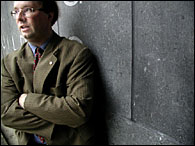Forensic architecture
Raynald Gauvin is an expert in electron microscopy -- one of 10 such specialists across Canada. Think of him as a forensic expert. But instead of inspecting blood and bones under his microscope, Gauvin investigates materials and metals.
 Professor Raynald Gauvin
Professor Raynald GauvinPHOTO: Claudio Calligaris |
|
A professor in the Department of Mining, Metals and Materials Engineering, Gauvin has been teaching at McGill since 2001. He was lured here from l'Université de Sherbrooke, in part, thanks to a high-powered Hitachi microscope that McGill owns.
The microscope is one of 10 such devices in Canada. It's located in the Wong Bldg., is the size of a family freezer and can magnify items up to 500,000 times under its powerful lens. The bulky tool is essential to Gauvin's trade, given that electron microscopy is a specialty that examines the structural and chemical characterization of materials.
Simply put, electron micro-scopy provides information about the morphology, grain size, chemical composition and crystallinity of materials. The high-resolution magnification provided by microscopy allows the quantitative analysis, or structural study, of a variety of substances: cements, ceramics, polymers, steel, aluminum or any kind of metal.
"Microscopy is part of a classical triangle: materials properties, processing and microstructure," Gauvin says, adding scientists are always striving to better understand the triple connection.
While the general public might be generally clueless about the work of electron microscopists, microscopists always have the public welfare in mind when doing their jobs. Indeed, electron microscopy is often used to determine if a metal or cement will withstand time's punishment when used to build parts of vehicles, buildings, roads and bridges.
The technique can also be used to collect clues after tragedies. When planes crash, for example, electron microscopy is used to pinpoint the cause: Did the engine suffer metal fatigue due to a bad mix of materials or was another factor the culprit? "By using electron microscopy," Gauvin says, "scientists are able to prove theories."
Gauvin says he's consumed with his field. "There's such a beauty behind the physics of materials," he says. "Every new material provides scientists with a challenge -- to characterize it."
Electron microscopy specialists still have much work ahead of them if they are to develop more tools for quantitative analysis of materials, Gauvin stresses. Better testing of materials would benefit companies, and ultimately consumers, since flawless materials result in better products, from computer chips to aluminum car wheel mags.
"With more precise testing companies can improve the quality and characterization of materials," Gauving says, adding even the Olympic Stadium, which included a series of bad roofs in its structural problems, could have avoided many of its ails with more in-depth testing.
Gauvin is also an advocate of training more engineers and microscopy experts. That's why he loves being a professor. "I'm passionate about teaching."
Sally Warner, a fourth-year mechanical engineering student, agrees. "Professor Gauvin was one of the most animated and passionate professor I've ever had," she says.
When taking Gauvin's class of Materials Science and Engineering last winter, Warner says the professor's penchant for illustrating his lectures proved infectious. "He'd get really excited as he talked about structural fatigue and constantly point to cracks in walls to prove his point," she says. "Or he'd tear off part of the trash can's plastic bag to show plastic deformation."
"A lot of bags were ripped during that class, since he tore bags over and over again to make us laugh and hammer his point across."
Be it through research or teaching, Gauvin says, his number one goal is to get his students to ask a multiplicity of questions. "I want to transmit my passion for my field," he says, "so that the field can grow to train future scientists."

